GRIN Fiber Optic Collimators / Couplers, Multimode Fiber
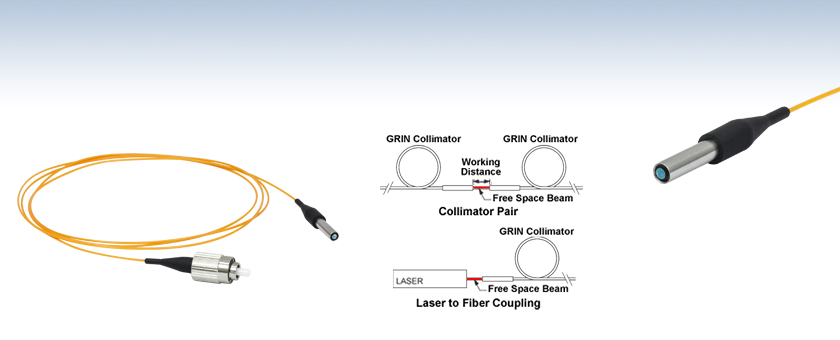
- GRIN Lens Couples and Collimates Light
- AR-Coated Lens Surface
- 1310 nm or 1550 nm Alignment Wavelength
- Pigtailed Multimode Fiber with Optional FC/PC or FC/APC Connector
50-1550M-FC
GRIN Lens is Housed
Inside a Ø3.4 mm
Stainless Steel Housing

Please Wait
| Common Specifications | |
|---|---|
| Collimator Pair Performance | |
| Working Distancea | 15 ± 5 mm |
| Pair Insertion Lossb | ≤0.35 dB |
| Individual Performance | |
| Insertion Lossc | ≤0.35 dB |
| Min Return Lossc | ≥30 dB (Typ.) |
| General | |
| Operating Wavelength Range | Alignment Wavelength ± 40 nm |
| Clear Aperture | Ø1.8 mm |
| Optical Power | 300 mW (Max) |
| GRIN Lens Material | Oxide Glass |
| Fiber Type | Corning PI360 Graded Index, 1 m Long |
| Fiber NA | 0.275 ± 0.015 |
| Core Diameter | Ø62.5 ± 3.0 µm |
| Cladding Diameter | Ø125 ± 2.0 µm |
| Fiber Jacket | Ø900 µm Hytrel®d Tubing (Orange) |
| Tensile Load | 5 N (Max) |
| Operating Temperature | 0 to 70 °C |
| Storage Temperature | -40 to 85 °C |
Features
- Couple and Collimate Light Into or Out of a Fiber
- Pigtailed to Graded-Index Multimode Fiber with an Optional FC/PC or FC/APC Connector
- Lens Surface is AR Coated for the Specified Wavelength Range
- Ø1.8 mm Clear Aperture
- 300 mW Maximum Power
Thorlabs offers pigtailed fiber collimators that use Graded-Index (GRIN) lenses. These GRIN collimators feature a Ø1.8 mm clear aperture and are coupled to graded-index multimode (MM) fiber. They are designed to be used in pairs, with a free-space beam between the lenses. They can also be used individually, as a single collimator or coupler. We offer models aligned at 1310 nm or 1550 nm and with a choice of an unterminated fiber end, a 2.0 mm narrow key FC/PC connector, or a 2.0 mm narrow key FC/APC connector. Contact Tech Support for custom connector options.
We also offer single mode pigtailed GRIN collimators and loose GRIN lenses, which can be paired with single mode pigtailed ferrules that have terminated or unterminated fiber ends to create a custom collimator similar to those sold on this page. For Thorlabs' complete selection of fiber collimators, please see the Collimator Guide tab.
Free-Space Coupling
When using GRIN collimators to couple a free-space beam into a fiber, precise alignment is needed for good coupling efficiency. We recommend using a kinematic tip and tilt mount and lens tube adapter, paired with an XYZ adjustable platform (such as our POLARIS-K05T6, SM05PT, sold below, and MT3), or our 6-axis kinematic mount paired with a lens tube adapter (K6XS and SM1PT, sold below).
Collimator Pair with Free-Space Beam
Our GRIN pigtailed collimators are designed to be used in pairs, with a free-space beam between the lenses. This free-space beam can be manipulated with many types of optics prior to entering the second lens. The collimators should be placed with a spacing of 15 ± 5 mm (working distance) between the front lens surfaces for maximum coupling efficiency. When used within the specified working distance and mounted on tip-tilt mounts, typical insertion losses of ≤0.35 dB are possible.

Click to Enlarge
GRIN Collimator Pair with Free-Space Beam, Mounted with
POLARIS-K05T6 Mirror Mounts and SM05PT Adapters (Sold Below)
Click on the Pair Performance icon in the tables below to view experimentally measured coupling efficiency data for each collimator pair as a function of the spacing between the collimators. Although the optimal working distance will slightly deviate for any two individual collimators due to small manufacturing variations, these slight deviations do not significantly affect pair or individual performance. This is evidenced by the data given below, which was taken with randomly selected collimators. To achieve the best possible coupling, we recommend mounting both collimators in kinematic adjustable mounts, such as the POLARIS-K05T6 with SM05PT, sold below, for final alignment. All specifications, including beam diameter, beam distance, and pair insertion loss, are guaranteed at a working distance of 15 ± 5 mm for any given collimator pair.
Thorlabs also offers a modular fiber/free-space setup, the FiberBench, which can accommodate pre-aligned FiberPort collimators and allows modular optical components to be placed in the beam path.
Loose GRIN Lenses
Thorlabs also offers single wavelength or broadband loose GRIN lenses for use with either a single wavelength or broadband light source. These GRIN lenses can be paired with our single mode pigtailed ferrules, which are offered with or without connectors. In contrast to the products sold on this page, these options allow the combination of GRIN lens and pigtailed ferrule to be chosen individually, satisfying a wide range of experimental requirements.
Insights into Best Lab Practices
Scroll down to read about a practice we follow when setting up lab equipment.
- Align Fiber Collimators to Create Free Space Between Fibers
Click here for more insights into lab practices and equipment.
Align Fiber Collimators to Create Free Space Between Fibers
Two collimators, inserted into a fiber optic setup, provide free-space access to the beam. The first collimator accepts the highly diverging light from the first fiber and outputs a free-space beam, which propagates with an approximately constant diameter to the second collimator. The second collimator accepts the free-space beam and couples that light into the second fiber. Some collimation packages, including the pair used in this demonstration, are designed for use with optical fibers and mate directly to fiber connectors.
Ideally, 100% of the light emitted by the first fiber would be coupled into the second fiber, but some light will always be lost due to reflections, scattering, absorption, and misalignment. Misalignment, typically the largest source of loss, can be minimized using the alignment and stabilization techniques described in this video.
In this demonstration, the first fiber is single mode. The optical power incident on the second collimator, as well as the power output by the second fiber, are measured. When the second fiber is multimode with a 50 µm diameter core, alignment resulted in 91% of the power incident on the second collimator being measured at the fiber output. This value was 86% when the second fiber is single mode. Some differences in collimator designs, and their effects on the characteristics of the collimated beams, are also discussed.
If you would like more information about tips, tricks, and other methods we often use in the lab, we recommend our other Video Insights. In addition, our webinars provide practical and theoretical introductions to our different products.
| Products Featured During Demonstration | ||||
|---|---|---|---|---|
| Fiber-Coupled Laser | Kinematic Mounts | Fiber Adapter Cap (for Power Sensor) |
Single Mode Patch Cable (FC/PC) | Fiber Cable Storage Reels |
| Triplet Fiber Optic Collimators | Power Sensor | Power Meter | Hybrid Single Mode Patch Cable | 2" Posts |
| Adapter (Mount-to-Collimator) |
SM1 Thread Adapter (for Power Sensor) |
Fiber Connector Cleaner | Step-Index Multimode Patch Cable | Ø1/2" Post Holders |
Date of Last Edit: April 21, 2021
| Posted Comments: | |
yong jiang
(posted 2019-10-14 14:50:32.483) 我们需要该产品的Zemax模型,麻烦提供一下,谢谢 YLohia
(posted 2019-10-14 12:05:49.0) Hello, thank you for contacting Thorlabs. One of our Applications Engineers from our Thorlabs China group will reach out to you directly. dipak1989
(posted 2019-01-08 06:18:55.12) Do you have GRIN fiber optic collimator for multimode fiber at 785 nm? YLohia
(posted 2019-04-01 03:44:53.0) Hello, thank you for contacting Thorlabs. Special item inquiries can be sent by clicking the red "Request Quote" above. I reached out to you at the time of your feedback post to gather more details about your application/requirements. christopher.betters
(posted 2016-04-20 19:33:19.027) Are these available with other GRIN lens options? besembeson
(posted 2016-04-21 01:46:21.0) Response from Bweh at Thorlabs USA: Yes we could offer special versions depending on what your requirements are. I will contact you. xbarci00
(posted 2015-07-01 14:46:18.09) Dear Sir/Madam,
I would like to ask you,what is the distance between MM fiber and the GRIN lens? What type of the GRIN is exactly used in this collimator (50-1550M-APC).
Thank you very much.
Kind Regards
Peter Barcik besembeson
(posted 2015-09-22 08:41:37.0) Response from Bweh at Thorlabs USA: The fiber is bonded to the GRIN such as those on this page: http://www.thorlabs.de/newgrouppage9.cfm?objectgroup_id=1209&pn=GRIN2315A. I will follow-up with you by email regarding your application. xgsun
(posted 2015-01-16 11:42:56.54) do you have GRIN Fiber Optic Collimators / Couplers, Multimode Fiber at 1064nm? besembeson
(posted 2015-01-22 05:27:59.0) Response from Bweh at Thorlabs USA: We have the single mode collimators for 1064nm (50-1064), and we can provide the multimode version as a custom item for now. I will follow-up with you by email for quotation. |
Fiber Collimator Selection Guide
Click on the collimator type or photo to view more information about each type of collimator.
| Type | Description | |
|---|---|---|
| Fixed FC, APC, or SMA Fiber Collimators |  |
These fiber collimation packages are pre-aligned to collimate light from an FC/PC-, FC/APC-, or SMA-terminated fiber. Each collimation package is factory aligned to provide diffraction-limited performance for wavelengths ranging from 405 nm to 4.55 µm. Although it is possible to use the collimator at detuned wavelengths, they will only perform optimally at the design wavelength due to chromatic aberration, which causes the effective focal length of the aspheric lens to have a wavelength dependence. |
| Air-Spaced Doublet, Large Beam Collimators | 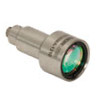 |
For large beam diameters (Ø5.3 - Ø8.5 mm), Thorlabs offers FC/APC, FC/PC, and SMA air-spaced doublet collimators. These collimation packages are pre-aligned at the factory to collimate a laser beam propagating from the tip of an FC or SMA-terminated fiber and provide diffraction-limited performance at the design wavelength. |
| Triplet Collimators |  |
Thorlabs' High Quality Triplet Fiber Collimation packages use air-spaced triplet lenses that offer superior beam quality performance when compared to aspheric lens collimators. The benefits of the low-aberration triplet design include an M2 term closer to 1 (Gaussian), less divergence, and less wavefront error. |
| Achromatic Collimators for Multimode Fiber |  |
Thorlabs' High-NA Achromatic Collimators pair a meniscus lens with an achromatic doublet for high performance across the visible to near-infrared spectrum with low spherical aberration. Designed for use with high-NA multimode fiber, these collimators are ideal for Optogenetics and Fiber Photometry applications. |
| Reflective Collimators |  |
Thorlabs' metallic-coated Reflective Collimators are based on a 90° off-axis parabolic mirror. Mirrors, unlike lenses, have a focal length that remains constant over a broad wavelength range. Due to this intrinsic property, a parabolic mirror collimator does not need to be adjusted to accommodate various wavelengths of light, making them ideal for use with polychromatic light. Our fixed reflective collimators are recommended for collimating single and multimode fiber and coupling into multimode fiber. These collimators are available with UV-enhanced aluminum or protected silver reflective coatings and with FC/PC, FC/APC, or SMA connector compatibility. |
| Compact Reflective Collimators | 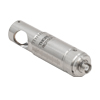 |
Thorlabs' Compact Reflective Collimators incorporate a 90° off-axis parabolic mirror with a protected silver coating. Because the focal length is independent of wavelength for an off-axis parabolic mirror, they are ideal for use with polychromatic light. Our fixed reflective collimators are recommended for collimating single and multimode fiber and coupling into multimode fiber. These collimators are directly compatible with our 16 mm cage system. They are available with FC/PC, FC/APC, or SMA connector inputs. |
| Adjustable Reflective Collimators |  |
Thorlabs' Adjustable Focus Reflective Collimators are based on a 90° off-axis parabolic (OAP) mirror with a protected silver coating. The adjustable fiber-to-OAP distance, combined with the OAP having a constant focal length across wavelengths, makes these collimators ideal for optimizing collimation or coupling of polychromatic light with single mode or multimode fiber. These adjustable collimators have a 15 mm reflected focal length and are available with FC/PC, FC/APC, or SMA connectors. |
| FiberPorts | 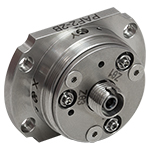 |
These compact, ultra-stable FiberPort micropositioners provide an easy-to-use, stable platform for coupling light into and out of FC/PC, FC/APC, or SMA terminated optical fibers. It can be used with single mode, multimode, or PM fibers and can be mounted onto a post, stage, platform, or laser. The built-in aspheric or achromatic lens is available with five different AR coatings and has five degrees of alignment adjustment (3 translational and 2 pitch). The compact size and long-term alignment stability make the FiberPort an ideal solution for fiber coupling, collimation, or incorporation into OEM systems. |
| Adjustable Fiber Collimators |  |
These collimators are designed to connect onto the end of an FC/PC, FC/APC, or SMA connector and contain an AR-coated aspheric lens. The distance between the aspheric lens and the tip of the fiber can be adjusted to compensate for focal length changes or to recollimate the beam at the wavelength and distance of interest. |
| Achromatic Fiber Collimators with Adjustable Focus |  |
Thorlabs' Achromatic Fiber Collimators with Adjustable Focus are designed with an effective focal length (EFL) of 20 mm, 40 mm, or 80 mm, have optical elements broadband AR coated for one of three wavelength ranges, and are available with FC/PC, FC/APC, or SMA905 connectors. A four-element, air-spaced lens design produces superior beam quality (M2 close to 1) and less wavefront error when compared to aspheric lens collimators. These collimators can be used for free-space coupling into a fiber, collimation of output from a fiber, or in pairs for collimator-to-collimator coupling over long distances, which allows the beam to be manipulated prior to entering the second collimator. |
| Zoom Fiber Collimators |  |
These collimators provide a variable focal length between 6 and 18 mm, while maintaining the collimation of the beam. As a result, the size of the beam can be changed without altering the collimation. This universal device saves time previously spent searching for the best suited fixed fiber collimator and has a very broad range of applications. They are offered with FC/PC, FC/APC, or SMA905 connectors with three different antireflection wavelength ranges to choose from. |
| Single Mode Pigtailed Collimators | 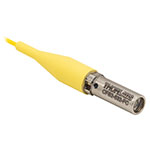 |
Our single mode pigtailed collimators come with one meter of fiber, consist of an AR-coated aspheric lens pre-aligned with respect to a fiber, and are collimated at one of eight wavelengths: 532 nm, 633 nm, 780 nm, 850 nm, 1030 nm, 1064 nm, 1310 nm, or 1550 nm. Although it is possible to use the collimator at any wavelength within the coating range, the coupling loss will increase as the wavelength is detuned from the design wavelength. |
| Polarization Maintaining Pigtailed Collimators | 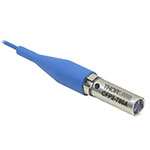 |
Our polarization maintaining pigtailed collimators come with one meter of fiber, consist of an AR-coated aspheric lens pre-aligned with respect to a fiber, and are collimated at one of five wavelengths: 633 nm, 780 nm, 980 nm, 1064 nm, or 1550 nm. Custom wavelengths and connectors are available as well. A line is engraved along the outside of the housing that is parallel to the fast axis. As such, it can be used as a reference when polarized light is launched accordingly. Although it is possible to use the collimator at any wavelength within the coating range, the coupling loss will increase as the wavelength is detuned from the design wavelength. |
| GRIN Fiber Collimators |  |
Thorlabs offers gradient index (GRIN) fiber collimators that are aligned at a variety of wavelengths from 630 to 1550 nm and have either FC terminated, APC terminated, or unterminated fibers. Our GRIN collimators feature a Ø1.8 mm clear aperture, are AR-coated to ensure low back reflection into the fiber, and are coupled to standard single mode or graded-index multimode fibers. |
| GRIN Lenses |  |
These graded-index (GRIN) lenses are AR coated for applications at 630, 830, 1060, 1300, or 1560 nm that require light to propagate through one fiber, then through a free-space optical system, and finally back into another fiber. They are also useful for coupling light from laser diodes into fibers, coupling the output of a fiber into a detector, or collimating laser light. Our GRIN lenses are designed to be used with our Pigtailed Glass Ferrules and GRIN/Ferrule sleeves. |

| Item # | Connector | Wavelength Range | Alignment Wavelength | Beam Diameter | Beam Divergence | Pair Performance (Click Graph to Enlarge) |
|---|---|---|---|---|---|---|
| 50-1310M | - | 1270 - 1350 nm | 1310 nm | 1.1 mm (Max) | 1.5° (Typ.) 2.0° (Max) |
(Raw Data) |
| 50-1310M-FC | FC/PC | |||||
| 50-1310M-APC | FC/APC |

| Item # | Connector | Wavelength Range | Alignment Wavelength | Beam Diameter | Beam Divergence | Pair Performance (Click Graph to Enlarge) |
|---|---|---|---|---|---|---|
| 50-1550M | - | 1510 - 1590 nm | 1550 nm | 0.9 mm (Max) | 1.0° (Typ.) 1.2° (Max) |
(Raw Data) |
| 50-1550M-FC | FC/PC | |||||
| 50-1550M-APC | FC/APC |

| Item # | External Threading | Compatible Component Size | Length | |
|---|---|---|---|---|
| Diameter | Length | |||
| SM05PT | SM05 (0.535"-40) | 3.5 mm | ≥0.26" (6.6 mm) | 0.50" (12.7 mm) |
| SM1PT | SM1 (1.035"-40) | |||
- External SM05 (0.535"-40) or SM1 (1.035"-40) Threads
- Ø0.14" (Ø3.5 mm) Center Hole
- Nylon-Tipped Setscrew Secures GRIN Collimator
These adapters are designed to mount Thorlabs' GRIN Lens Fiber Collimators in SM05- or SM1-compatible mounts, lens tubes, and cage components. The adapters' design ensures that the GRIN lens is aligned with the optical axis when mounted into a lens tube. A 1/16" (1.5 mm) hex, nylon-tipped setscrew is used to press the GRIN lens fiber collimator against the two lines of contact created by the double-bored mounting hole. Additionally, each adapter has holes on opposing sides of the central bore for use with a spanner wrench. The SM05PT is compatible with the SPW908 spanner wrench while the SM1PT is compatible with the SPW801 and SPW909 spanner wrenches.


Click to Enlarge
FCM34 Ferrule Clamp with a GRIN Collimator
- Compact Flexure Clamp for Ø3.4 mm GRIN Collimator Housing
- 8-32 (M4) Tapped Mounting Hole
- Compatible with Ø1/2" Optical Posts
This Post-Mountable Ferrule Clamp allows GRIN Collimators to be mounted securely and compactly within an experimental setup. The collimator is clamped into the flexure mount using a 5/64" (2 mm) hex key. An 8-32 (M4) tapped hole on the bottom of the mount provides compatibility with our Ø1/2" optical posts.
 Products Home
Products Home













 Zoom
Zoom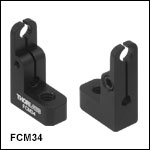
 Multimode GRIN Collimators
Multimode GRIN Collimators